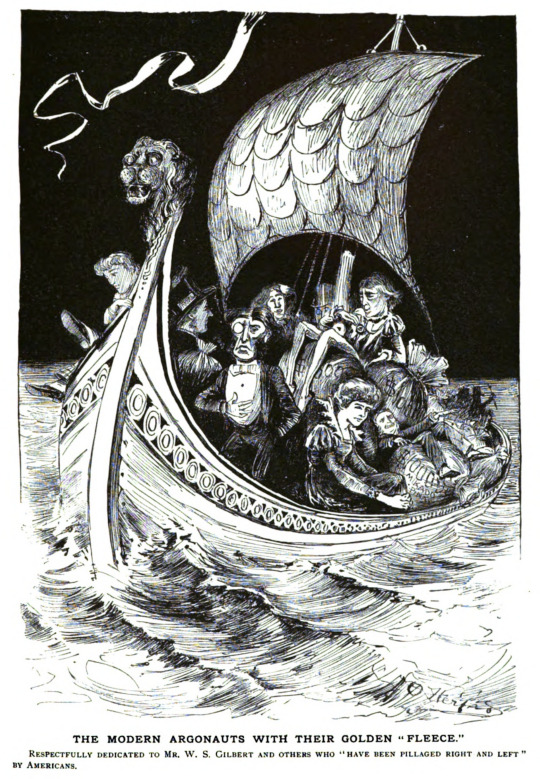#Frederic Farrar
Text
Fleeced
Life, (New York), March 11, 1886, No. 167.
—The Question of Copyright—
Speaking of copyright, as I was in my recent post about The Sarony Case, reminds me that the 1880s was a vexed period for authorship rights, and matters could get a little fraught.
Continue reading Untitled

View On WordPress
#Oscar Wilde#cartoon#Copyright#Frederic Farrar#gilbert and sullivan#Harper and Brothers#henry irving#Life Magazine#lillie langtry#Matthew Arnold#Oliver Herford#W.S. Gilbert
1 note
·
View note
Text
adventures in christian opinions about judaism
(reposted from Twitter)
So a while back I started writing a thing on the trio of parables that ends with the prodigal son (which I still need to finish) and like MAN OH MAN do Christian commentators insist that Jews hate shepherds.
Like, I can't even count the number of commentaries that insist that shepherds were "despised figures" for first-century Jews and the parables of the lost sheep and lost coin were designed to insult the Pharisees by comparing them first to a shepherd and then to a woman.
So, as is my wont whenever Christian commentators make a claim about what was normal for first-century Judaism, I decided to try to hunt down their source on this.
As I've said many times, when it comes to Christian parable interpreters' claims about what attitudes/beliefs/etc. were normal for first-century Jews, get used to the phrase "no sources are cited."
I mean, first off, as a 21st-century Jew, the insistence that 1st-century Jews hated shepherds rings odd, given that <checks notes> Abraham, Isaac, Jacob, Rachel, all of Jacob's kids (the founders of the tribes), David, etc. were all sheep-tenders. The image of God as a shepherd is pretty consistent throughout the Tanakh. That image reappears in the Qumran texts, which as far as I know, are one of the few Jewish sources we have from 1st-century Judaea.
The term "despised" gets used a lot, so I decided to dig into that one.




When I was able to find citations, I traced them back to an 1882 commentary by a guy named Frederic Farrar.
Farrar cites Heinrich Meyer as a source for this, but when I looked up THAT citation, it's Meyer saying that shepherds were a "lowly but patriarchally consecrated class" -- in other words, poor, but with a distinguished history and status.
So that's why everyone's tossing the term "despised" around--because Farrar just made it up. But what about primary sources? I went back on the hunt.
Surprisingly, in a number of reference works, like glossaries and Jeffers's "Greco-Roman World of the New Testament," I found similar assertions about the common attitude toward shepherds, for which they cited...
<drum roll>
Aristotle. You know, the Greek guy who lived 300 years before Jesus? Definitely a reliable source for Jewish attitudes of the time.
Some people cited Philo's On Agriculture. Okay, Philo was at least Jewish and lived when Jesus would have, although he was a wealthy Hellenized Jew living in Alexandria rather than a Pharisee living in the Galilee. But okay, at least it's the right culture and time period. (The reference in Philo turns out to be talking about the section of Genesis in which Joseph's brothers come visit him in Egypt. It talks about how they were proud to be shepherds, and criticizes (gentile) kings who look down on shepherds.)
Then we've got Mishnah Kiddushin, in which a bunch of rabbis are having a debate about which professions make you trustworthy vs untrustworthy, and one rabbi lists everyone from camel-drivers to herders to barbers to shopkeepers as untrustworthy. Another rabbi comes back and is like, nah, all those people are fine upstanding folks; it's doctors and butchers you've gotta watch out for. So they're citing one cranky dude with a LONG list of people he doesn't like, who immediately gets shot down, as evidence of the normative attitude for Jews about a century earlier.
Oh, and we've got a citation of Midrash Tehillim which says that God-as-shepherd doesn't have any of the failings of humans-as-shepherds, which... sure. Also, it was codified in the 1300s?
The most compelling citation is from the Talmud (Sanhedrin 25b), in which the rabbis discuss who's qualified to be a legal witness. They exclude shepherds, because shepherds graze their animals on other people's land, which some of the rabbis see as a type of theft.
The Talmud is a record of debates, but this passage definitely makes it sound like this is a majority opinion. (It should be noted that the passage disqualifies all KINDS of people, from those who lend with interest to those who fly pigeons, as having conflicts of interest.)
But the important thing here is that the Talmud includes records of debates from as late as the 4th or 5th centuries CE (300-400 years after Jesus's time), and the passage makes a point of noting that the disqualification of shepherds as witnesses is a later development.
So in other words, the idea that the Pharisees hated shepherds and would have been insulted by Jesus telling a story in which the protagonist was a shepherd is based either on Greek attitudes that are 300 years too early or Jewish ones that are 300-400 years too late.
But people will twist themselves into citation knots (or just not bother citing a source at all) to insist that this was a common attitude so they can position the Pharisees as hating those charming humble shepherds and their fuzzy little lambs.
As to WHY this idea seems to be so important to them, well, you cannot read about Luke 15 without encountering the word "outcast" roughly 90 times per page.
The framing is Jesus was friend to The Outcasts while the Pharisees despised The Outcasts and the Lost Sheep, Coin, and Sons are all parables about accepting The Outcast.
Never mind that neither the sheep, the coin, nor either of the sons got kicked out of their communities. The sheep wandered off, as sheep are wont to do, the coin was lost by its owner, and the younger son decided to leave to go on a spending spree while the older son declined to attend the welcome back party for him after his dad managed to hire a band and caterers but never thought to let his own son know what was going on and he had to find out from a hired hand.
Moreover, the term "outcasts" gets used as a synonym for "tax collectors and sinners." Tax collectors were usually pretty well-off because they ran a protection racket for the Romans. Outcasts? I mean, I guess? But hardly in the "marginalized and powerless" sense.
As far as "sinners," the NT doesn't usually bother telling us what, exactly, they did to "sin," but on the rare occasions when it does offer that context, it's almost always wealthy people.
But why talk about that when they can present the objection the Pharisees had to Jesus's dining with "tax collectors and sinners" as the Pharisees despising lowly outcasts, and insist that the Pharisees hated the idea of such people repenting and returning, and so Jesus was tweaking their noses by comparing them to shepherds and women.
As if, you know, teshuvah wasn't something the Pharisees were ALL ABOUT. If you want to actually understand, consider that the iconic tax collector in the parable of the Pharisee and the tax collector shows no inclination to STOP being a tax collector.
The objection wasn't you're having a friendly dinner with poor lowly outcasts for whom we have contempt. It was you're having a friendly dinner with people who are extorting their neighbors on behalf of the invaders who kill us for looking at them funny and have expressed no intention to stop doing that.
Now, there's a good discussion to be had about whether shunning Trump lawyers and Marjorie Taylor-Greene donors or inviting them to dinner and trying to win them over with compassion is more effective, more ethical, more compassionate (to whom?), etc.
But presumably we can see why people of intelligence and goodwill might disagree on which of those approaches is the right thing to do, and why such people might might object to the strategy they don't agree with.
But what really gets me is that Christians have the utter fucking NERVE to paint the Pharisees as inhumanly awful for not wanting to have dinner with tax collectors while viewing Corinthians as Holy Writ:

I mean, Paul's all YOU MUST SHUN ALCOHOLICS AND PEOPLE WHO ARE GREEDY and Christians are like yes, that makes sense, but if the Pharisees are like, no, I don't want to have dinner with that guy who narced on my cousin and got him crucified, Christians are like, they're monsters.
Cool, cool.
Anyway, this has been your weekly edition of Christians Need To Stop Just Making Shit Up About Jews And Then Citing Each Other Like It's Fact.
And there were a lot of "I've never heard anyone say Jews of Jesus's time hated shepherds..." responses: Maybe you haven't, but that doesn't make it uncommon.
Sources in which I've found it:
Craig Blomberg (Denver Seminary, Society of Biblical Literature, Tyndale House, NIV translation committee)
Jared Wilson (professor at multiple Baptist seminaries)
Stephen Wright (Spurgeon College (British evangelical college))
Arland Hultgren (Luther Seminary (ELCA))
Kenneth Bailey (Presbyterian/Episcopalian)
Joachim Jeremias (Lutheran, cited EVERYWHERE)
Bernard Brandon Scott (Disciples of Christ, the Jesus Seminar)
Klyne Snodgrass (Evangelical Covenant Church)
Barbara Reid (Catholic Biblical Association)
That particular trope spans denominations, decades, etc. It's not a fringe viewpoint.
#christian exegesis#antisemitism#jumblr#citational politics#bad methodology#parables#pharisees#first century judaism#second temple judaism#good shepherd#prodigal son#why are christians like this?
366 notes
·
View notes
Text
To-read list for 2023
Finish reading
The Monk by Matthew Lewis
The Midnight Library by Matt Haig
The Poe Clan by Moto Hagio
Start reading
Les Misèrables by Victor Hugo (reread)
The Rose of Versailles (French edition) by Riyoko Ikeda
A Drunken Dream and Other Stories and Lil’ Leo by Moto Hagio
The Tale of Genji by Murasaki Shikibu
Corto Maltese: The Ballad of the Salt and Sea by Hugo Pratt — and possibly the rest of the Corto Maltese series, if I like it
The Well of Loneliness by Radclyffe Hall
Eric, or, Little by Little by Frederic Farrar
Great Expectations by Charles Dickens — and other works that are in my anthology
#my goals are to read more manga and more classics#and in particular i enjoy victorian literature so i am willing to read tripe like ‘little by little’#personal
2 notes
·
View notes
Text

L'HORREUR DE LA CRUCIFIXION
Un dirigeant d’Église anglais du XIXe siècle, Frederic Farrar, a écrit cette description des horreurs de la crucifixion :
[Sur la croix], dans des tortures de plus en plus insupportables, qui rendaient de plus en plus fou au fur et à mesure que le temps passait, les malheureuses victimes pouvaient rester dans une mort vivante si intolérable que souvent, elles en venaient à supplier et à implorer les spectateurs ou les bourreaux, par pitié, de mettre fin à un supplice trop affreux à supporter. Conscients jusqu’au bout, et souvent versant des larmes de souffrance abjecte, ils imploraient leurs ennemis de leur accorder la bénédiction inestimable de la mort.
En effet, une mort par crucifixion semble inclure tout ce que la souffrance et la mort peuvent avoir d’horrible et d’épouvantable : vertiges, crampes, soif, inanition, insomnie, fièvre traumatique, tétanos, humiliation publique, tourment prolongé, horreur de l’anticipation, nécrose des blessures laissées ouvertes. Ces souffrances s’intensifiaient jusqu’à la limite de ce qui pouvait être enduré, en s’arrêtant juste avant le point qui aurait pu donner à la victime le soulagement d’une perte de connaissance. La position anormale rendait chaque mouvement douloureux. Les veines lacérées et les tendons écrasés palpitaient d’une souffrance incessante ; les blessures ouvertes étaient exacerbées par l’exposition et se gangrénaient graduellement. Les artères, en particulier celles de la tête et de l’estomac, se gonflaient sous l’effet de la surcharge de sang. Et alors que toutes sortes de souffrances s’empiraient, s’ajoutait l’intolérable tourment d’une soif brûlante et incessante. L’ensemble de ces complications physiques causait alors un trouble et une anxiété internes qui donnaient à la mort imminente, cette infâme ennemie inconnue qui fait habituellement frémir les hommes, une allure de libération exquise et recherchée.
Cet article est tiré du livre : L’Évangile selon Dieu de John MacArthur
0 notes
Text
Odds & Ends: April 21, 2023
Century of the Self. We recently revisited this 4-part documentary from Adam Curtis and found it just as engaging and eye-opening as we did watching it the first time a couple decades back. Curtis explores the way Freudian ideas and the movement towards self-expression in the 60s ended up being co-opted by advertisers, corporations, and politicians and channeled towards consumerism, so that what promised to liberate the human psyche, actually ended up making people more manipulated and controlled. It’s a must-watch for the modern citizen.
“The Horse Whisperer” by Mark Maggiori. I’ve been a fan of the Western artist Mark Maggiori for several years now. I love his paintings depicting the American West. The way he paints clouds in the desert is amazing. Whenever I’m on a road trip in New Mexico and see a big pillar of clouds, I lean over and tell Kate, “Those are some Mark Maggiori clouds right there.” When I turned 40 a few months ago, a dear friend gifted me a print of Maggiori’s painting, “The Horse Whisperer.” It depicts an old cowboy that looks like my favorite literary cowboy, Lonesome Dove’s Gus McCrae, riding his horse amongst the sage brush. And, of course, there are some great Mark Maggiori clouds in the sky. When you order a Maggiori print, it can take months to get to you, and it just finally arrived. Can’t wait to get it framed and hung up in my living room.
“Is There a Loneliness Epidemic?” You hear a lot of talk in the media these days about a “loneliness epidemic” going on in the West. We’ve even had several podcast guests bring up the idea on the show. But is there really a loneliness epidemic afoot? According to this article, no. Looking at the data, the author concludes: “today’s adolescents in the US do not seem to be more likely to report feeling lonely than adolescents from a couple of decades ago; and similarly, today’s older adults in the US do not report higher loneliness than did adults of their age in the past.” Guess it’s just the kind of narrative/buzz-phrase that makes for good copy.
“Only the Young” by Brandon Flowers. If you’ve been following AoM for a while now, you know that I’m a big Killers fan. I’m also a big fan of the solo projects frontman Brandon Flowers has done over the years. His 2010 solo album Flamingo is packed with several underrated and overlooked gems. But the track that’s been getting the most play in McKay-family transportation lately is “Only the Young.” It’s so dang good. The music video is just as good. Makes me nostalgic for being young again but also hopeful for my kids.
Quote of the Week
There is only one real failure in life that is possible, and that is, not to be true to the best one knows.
—Frederic Farrar
The post Odds & Ends: April 21, 2023 appeared first on The Art of Manliness. http://dlvr.it/SmsNV8
1 note
·
View note
Text
Good Friday Quotes
Good Friday is an important holiday observed by Christians around the world. It commemorates the crucifixion and death of Jesus Christ, who died for the sins of humanity.

here are some famous quotes from the Bible:
"The Lord is my shepherd, I lack nothing." - Psalm 23:1
"Be strong and courageous. Do not be afraid or discouraged, for the Lord your God will be with you wherever you go." - Joshua 1:9
"Trust in the Lord with all your heart and lean not on your own understanding; in all your ways submit to him, and he will make your paths straight." - Proverbs 3:5-6
"I can do all things through Christ who strengthens me." - Philippians 4:13
"Love your neighbor as yourself." - Mark 12:31
"For God so loved the world that he gave his one and only Son, that whoever believes in him shall not perish but have eternal life." - John 3:16
"For all have sinned and fall short of the glory of God." - Romans 3:23
Some Famous Good Friday Quotes in the below;

"By the cross we, too, are crucified with Christ; but alive in Christ. We are no more rebels, but servants; no more servants, but sons!" - Frederic Farrar
"It was not nails that held Jesus to that wretched cross; it was his unqualified resolution, out of love for his Father, to do his Father's will - and it was his love for sinners like me." - D.A. Carson
"The cross is the lightning rod of grace that short-circuits God's wrath to Christ so that only the light of His love remains for believers." - A.W. Tozer
"Our old history ends with the cross; our new history begins with the resurrection." - Watchman Nee
0 notes
Text
What does your Muse’s Name Mean? (Mega Children addition)


Rosamarie
Gender Feminine
Usage Various
Variant of Rosemarie.


Rosalynn/Rosalyn
Gender Feminine
Usage English
Variant of Rosaline. It can also be considered an elaboration of Rose with the common name suffix lyn.

Daniella
Gender Feminine
Usage English, Hungarian
Feminine form of Daniel, which is from the Hebrew name דָּנִיֵּאל (Daniyyel) meaning "God is my judge", from the roots דִּין (din) meaning "to judge" and אֵל ('el) meaning "God". Daniel was a Hebrew prophet whose story is told in the Book of Daniel in the Old Testament. He lived during the Jewish captivity in Babylon, where he served in the court of the king, rising to prominence by interpreting the king's dreams. The book also presents Daniel's four visions of the end of the world.
Due to the popularity of the biblical character, the name came into use in England during the Middle Ages. Though it became rare by the 15th century, it was revived after the Protestant Reformation. Famous bearers of this name include English author Daniel Defoe (1660-1731), Swiss mathematician Daniel Bernoulli (1700-1782), and American frontiersman Daniel Boone (1734-1820).

Eric
Gender Masculine
Usage English, Swedish, German, Spanish
Means "ever ruler", from the Old Norse name Eiríkr, derived from the elements ei "ever, always" and ríkr "ruler, mighty". A notable bearer was Eiríkr inn Rauda (Eric the Red in English), a 10th-century navigator and explorer who discovered Greenland. This was also the name of several early kings of Sweden, Denmark and Norway.
This common Norse name was first brought to England by Danish settlers during the Anglo-Saxon period. It was not popular in England in the Middle Ages, but it was revived in the 19th century, in part due to the children's novel Eric, or Little by Little (1858) by Frederic William Farrar.

Jeremy
Gender Masculine
Usage English, Biblical
English form of Jeremiah, originally a medieval vernacular form. This is the spelling used in some English versions of the New Testament.

Annalisa
Gender Feminine
Usage Italian
Combination of Anna and Lisa.

Blair
Gender Masculine & Feminine
Usage Scottish, English
From a Scottish surname that was derived from Gaelic blàr meaning "plain, field, battlefield". In Scotland this name is typically masculine.
In the United States it became more common for girls in the early 1980s, shortly after the debut of the television sitcom The Facts of Life (1979-1988), which featured a character named Blair Warner. The name left the American top 1000 rankings two decades later, but was resurrected by another television character, this time Blair Waldorf from the series Gossip Girl (2007-2112).

Noah
Gender Masculine
Usage English, German, Biblical
From the Hebrew name נֹחַ (Noach) meaning "rest, repose", derived from the root נוּחַ (nuach). According to the Old Testament, Noah was the builder of the Ark that allowed him, his family, and animals of each species to survive the Great Flood. After the flood he received the sign of the rainbow as a covenant from God. He was the father of Shem, Ham and Japheth.
As an English Christian name, Noah has been used since the Protestant Reformation, being common among the Puritans. In the United States it was not overly popular in the 19th and 20th centuries, but it began slowly growing in the 1970s. Starting 1994 it increased rapidly — this was when actor Noah Wyle (1971-) began starring on the television series ER. A further boost in 2004 from the main character in the movie The Notebook helped it eventually become the most popular name for boys in America between 2013 and 2016. At the same time it has also been heavily used in other English-speaking countries, as well as Germany, the Netherlands, Scandinavia and France.
A famous bearer was the American lexicographer Noah Webster (1758-1843).

Annika
Gender Feminine
Usage Swedish, Dutch, Finnish, Estonian, German, English (Modern)
Swedish diminutive of Anna.

Bella
Gender Feminine
Usage English
Short form of Isabella and other names ending in bella. It is also associated with the Italian word bella meaning "beautiful". It was used by the American author Stephenie Meyer for the main character in her popular Twilight series of novels, first released 2005, later adapted into a series of movies beginning 2008.

Primrosa
Gender Feminine
Usage English (Rare)
Variant of Primrose, which is from the English word for the flower, ultimately deriving from Latin prima rosa "first rose".



Rosa
Gender Feminine
Usage Spanish, Italian, Portuguese, Catalan, Swedish, Danish, Norwegian, Finnish, Dutch, German, English
Generally this can be considered a Latin form of Rose, though originally it may have come from the unrelated Germanic name Roza. This was the name of a 13th-century saint from Viterbo in Italy. In the English-speaking world it was first used in the 19th century. A famous bearer was civil rights activist Rosa Parks (1913-2005).

Rosalie
Gender Feminine
Usage French, German, Dutch, English
French, German and Dutch form of Rosalia. In the English-speaking this name received a boost after the release of the movie Rosalie (1938), which was based on an earlier musical.

Higana
Gender Feminine
Usage Japanese
From 彼岸花 higanbana (red spider lily) and 彼岸 higan (nirvana; literally means the other shore). The red spider lily is portrayed as the "flower of heavens" in Buddhist scriptures. However, it is also known as 死人花 shibitobana (flower of the dead) in Japan and symbolizes "sorrowful memories" in the language of flowers.

Botan
Gender Feminine
Usage Japanese (Rare)
From 牡丹 (botan), referring to the (Chinese tree) peony.
#『Roll the Dice and Hope for Snake Eyes』Quizzes and Games#a lot of sue's children's names can't be found#whoops#『v!Long live the Queen』
1 note
·
View note
Photo

. "Happy is the man who can recognise in the work of to-day a connected portion of the work of life and an embodiment of the work of Eternity." . Paper to Frederic Farrar (1854). . James Clerk Maxwell (Edinburgh, Scotland, 13 June 1831 – Cambridge, England, 5 November 1879). . #scottish #mathematician #scientist #classicaltheoryofelectromagneticradiation #electricity #magnetism #light #electromagnetism #maxwellsequations #maxwell #jamesclerkmaxwell #muchroom #macrolepiota #pride #pridemonth #porcía (en Porcía, Asturias, Spain) https://www.instagram.com/p/Cewh-7YsEfx/?igshid=NGJjMDIxMWI=
#scottish#mathematician#scientist#classicaltheoryofelectromagneticradiation#electricity#magnetism#light#electromagnetism#maxwellsequations#maxwell#jamesclerkmaxwell#muchroom#macrolepiota#pride#pridemonth#porcía
0 notes
Text
The Nativity

by Frederic W. Farrar
"And while they were there, the time came for her to give birth."
- Luke 2:6
One mile from Bethlehem is a little plain in which, under a grove of olives, stands the bare and neglected chapel known by the name of "the Angel to the Shepherds." It is built over the traditional site in the fields where, in the beautiful language of St. Luke, "there were shepherds keeping watch over their flock by night, when, lo, the angel of the Lord came upon them, and the glory of the Lord shone round about them." To their happy ears were uttered the good tidings of great joy, that unto them was born that day in the city of David a Savior, who was Christ the Lord.
The associations of our Lord's nativity were all of the humblest character, and the very scenery of his birthplace was connected with memories of poverty and toil. On that night, indeed, it seemed as though the heavens must burst to disclose their radiant minstrels. And the stars, the feeding sheep, the light and sound in the darkness and stillness, and the rapture of faithful hearts would combine to furnish us with a picture painted in the colors of heaven. But in the brief and thrilling verses of the Evangelist, we are not told that those angel songs were heard by any except the wakeful shepherds of an obscure village, those shepherds who amid the chill dew of a winter night were guarding their flocks from the wolf and robber.
"And suddenly," amid the indifference of a world unconscious of its Deliverer, "there was with the angel a multitude of the heavenly host, praising God and saying, Glory to God in the highest, and on earth peace among men of good will."
The shepherds made their way to the inn of Bethlehem and found Mary and Joseph, and the babe lying in a manger. The fancy of poet and painter has reveled in the imaginary glories of the scene. They have sung of the "bright harnessed angels" who hovered there, and of the stars lingering beyond their time to shed their sweet influences upon the smiling infant. They have painted the radiation of light from his manger cradle, illuminating all the place till the bystanders are forced to shade their eyes from that heavenly splendor. But all this is wide of the reality. Such glories as the simple shepherds saw were seen only by the eye of faith. The light that shined in the darkness was no physical beam but a spiritual one; the Dayspring from on high, who had now visited mankind, dawned only in a few faithful and humble hearts.
How long the Virgin Mother and her holy Child stayed in the cave, or cattle-enclosure, we cannot tell, but probably it was not for long. It is probable that the crowd in the khan would not be permanent, and common humanity would have dictated an early removal of the mother and her child to some more appropriate resting place. The Magi, as we see from St. Matthew, visited Mary in "the house." But on all these minor incidents the Gospels do not dwell. The fullest of them is St. Luke, and the singular sweetness of his narrative, its almost idyllic grace, its sweet calm tone of noble reticence, seem clearly to indicate that he derived it, though but in fragmentary notices, from the lips of Mary herself. It is, indeed, difficult to imagine from whom else it could have come, for mothers are the natural historians of infant years. It is interesting to find, in the actual style, the coloring of a woman's memory and a woman's view. To one who was giving the reins to his imagination, the minutest incidents would have claimed a description. To Mary they would have seemed trivial and irrelevant. Others might wonder, but in her all wonder was lost in the one overwhelming revelation. Of such things she could not lightly speak; "she kept all these things, and pondered them in her heart."
8 notes
·
View notes
Quote
Augustine must bear the fatal charge of being the first, as well as one of the ablest defenders of the frightful cause of persecution and intolerance. He was the first to misuse the words, 'Compel them to come in,' of the parable —a fragmentary phrase wholly unsuited to bear the weight of horror for which it was made responsible. He was the first and ablest asserter of the principle which led to Albigensian crusades, Spanish armadas, Netherlands' butcheries, St. Bartholomew massacres, the accursed infamies of the Inquisition, the vile espionage, the hideous bale fires of Seville and Smithfield, the racks, the gibbets, the thumbscrews, the subterranean torture-chambers used by churchly torturers who assumed 'the garb and language of priests with the trade and temper of executioners,' to sicken, crush, and horrify the revolted conscience of mankind.
Frederic William Farrar, Lives of the Fathers
2 notes
·
View notes
Quote
Jesus knew that the awful hour of His deepest humiliation had arrived--that from this moment till the utterance of that great cry with which He expired, nothing remained for Him on earth but the torture of physical pain and the poignancy of mental anguish. All that the human frame can tolerate of suffering was to be heaped upon His shrinking body; every misery that cruel and crushing insult can inflict was to weigh heavy on His soul; and in this torment of body and agony of soul even the high and radiant serenity of His divine spirit was to suffer a short but terrible eclipse. Pain in its acutest sting, shame in its most overwhelming brutality, all the burden of the sin and mystery of man'a existence in its apostasy and fall--this was what He must now face in all its most inexplicable accumulation.
Frederic Farrar, "Filled With Mercy"
#Frederic Farrar#Filled With Mercy#daily#book#quote#Sunday#April 16#2017#Easter#LDS#Mormon#The Church of Jesus Christ of Latter-day Saints
0 notes
Photo

“The finger of the spirit touched his breast.” From Allegories by Frederic W. Farrar, 1898.
Here are over 900 vintage ghosts I’ve invited over.
67 notes
·
View notes
Photo

🌛🌝🌜 Witchcraft Wednesday 🌛🌝🌜 🌛🌝🌜 Witchcraft Wednesday 🌛🌝🌜 Wicca, continued: Wicca was founded in England between 1921 and 1950, representing what the historian Ronald Hutton called "the only full-formed religion which England can be said to have given the world". Characterised as an "invented tradition" by scholars, Wicca was created from the patchwork adoption of various older elements, many taken from pre-existing religious and esoteric movements. Wicca took as its basis the witch-cult hypothesis, the idea that those persecuted as witches during the early modern period in Europe were not, as the persecutors had claimed, followers of Satanism, but were instead adherents of a surviving pre-Christian pagan religion. This theory had been first expressed by the German Professor Karl Ernest Jarcke in 1828, before being endorsed by German Franz Josef Mone and then the French historian Jules Michelet. In the late 19th century it was then adopted by two Americans, Matilda Joslyn Gage and Charles Leland, the latter of whom promoted a variant of it in his 1899 book, Aradia, or the Gospel of the Witches. The theory's most prominent advocate was the English Egyptologist Margaret Murray, who promoted it in a series of books – most notably 1921's The Witch-Cult in Western Europe and 1933's The God of the Witches – and in her entry on "witchcraft" for the Encyclopædia Britannica. The witch-cult theory represented "the historical narrative around which Wicca built itself", with the early Wiccans claiming to be the survivors of this ancient pagan religion. Other influences upon early Wicca included various Western esoteric traditions and practices, among them ceremonial magic, Aleister Crowley and his religion of Thelema, Freemasonry, Spiritualism, and Theosophy. To a lesser extent, Wicca also drew upon folk magic and the practices of cunning folk. It was further influenced both by scholarly works on folkloristics, particularly James Frazer's The Golden Bough, as well as romanticist writings like Robert Graves' The White Goddess, and pre-existing modern Pagan groups such as the Order of Woodcraft Chivalry and Druidism. It was during the 1930s that the first evidence appears for the practice of a pagan Witchcraft religion (what would be recognisable now as Wicca) in England. It seems that several groups around the country, in such places as Norfolk, Cheshire and the New Forest had set themselves up as continuing in the tradition of Murray's Witch-Cult, albeit with influences coming from disparate sources such as ceremonial magic, folk magic, Freemasonry, Theosophy, Romanticism, Druidry, classical mythology and Asian religions. Early development, 1936–1959 Edit The history of modern Wicca starts with Gerald Gardner (the "Father of Wicca") in the mid-20th century. Gardner was a retired British civil servant and amateur anthropologist, with a broad familiarity in paganism and occultism. He claimed to have been initiated into a witches' coven in New Forest, Hampshire, in the late 1930s. Intent on perpetuating this craft, Gardner founded the Bricket Wood coven with his wife Donna in the 1940s, after buying the Naturist Fiveacres Country Club. Much of the coven's early membership was drawn from the club's members and its meetings were held within the club grounds. Many notable figures of early Wicca were direct initiates of this coven, including Dafo, Doreen Valiente, Jack Bracelin, Frederic Lamond, Dayonis, Eleanor Bone and Lois Bourne. The Witchcraft religion became more prominent beginning in 1951, with the repeal of the Witchcraft Act of 1735, after which Gerald Gardner and then others such as Charles Cardell and Cecil Williamson began publicising their own versions of the Craft. Gardner and others never used the term "Wicca" as a religious identifier, simply referring to the "witch cult", "witchcraft", and the "Old Religion". However, Gardner did refer to witches as "the Wica". During the 1960s, the name of the religion normalised to "Wicca". Gardner's tradition, later termed Gardnerianism, soon became the dominant form in England and spread to other parts of the British Isles. Adaptation and spread, 1960–present Edit Following Gardner's death in 1964, the Craft continued to grow unabated despite sensationalism and negative portrayals in British tabloids, with new traditions being propagated by figures like Robert Cochrane, Sybil Leek and most importantly Alex Sanders, whose Alexandrian Wicca, which was predominantly based upon Gardnerian Wicca, albeit with an emphasis placed on ceremonial magic, spread quickly and gained much media attention. Around this time, the term "Wicca" began to be commonly adopted over "Witchcraft" and the faith was exported to countries like Australia and the United States. It was in the United States and in Australia that new, home-grown traditions, sometimes based upon earlier, regional folk-magical traditions and often mixed with the basic structure of Gardnerian Wicca, began to develop, including Victor Anderson's Feri Tradition, Joseph Wilson's 1734 Tradition, Aidan Kelly's New Reformed Orthodox Order of the Golden Dawn and eventually Zsuzsanna Budapest's Dianic Wicca, each of which emphasised different aspects of the faith. It was also around this time that books teaching people how to become Witches themselves without formal initiation or training began to emerge, among them Paul Huson's Mastering Witchcraft (1970) and Lady Sheba's Book of Shadows (1971). Similar books continued to be published throughout the 1980s and 1990s, fuelled by the writings of such authors as Doreen Valiente, Janet Farrar, Stewart Farrar and Scott Cunningham, who popularised the idea of self-initiation into the Craft. Among witches in Canada, anthropologist Dr. Heather Botting (nee Harden) of the University of Victoria has been one of the most prominent, having been the first recognized Wiccan chaplain of a public university. Original high priestess of Coven Celeste, she is one of the founders of the Canadian Aquarian Tabernacle Church. In the 1990s, amid ever-rising numbers of self-initiates, the popular media began to explore "witchcraft" in fictional films like The Craft (1996) and television series like Charmed (1998–2006), introducing numbers of young people to the idea of religious witchcraft. This growing demographic was soon catered to through the Internet and by authors like Silver RavenWolf, much to the criticism of traditional Wiccan groups and individuals. In response to the way that Wicca was increasingly portrayed as trendy, eclectic, and influenced by the New Age movement, many Witches turned to the pre-Gardnerian origins of the Craft, and to the traditions of his rivals like Cardell and Cochrane, describing themselves as following "Traditional Witchcraft". Prominent groups within this Traditional Witchcraft revival included Andrew Chumbley's Cultus Sabbati and the Cornish Ros an Bucca coven. Source: Wikipedia.com
3 notes
·
View notes
Link
Un dirigeant d’Église anglais du XIXe siècle, Frederic Farrar, a écrit cette description des horreurs de la crucifixion :
En effet, une mort par crucifixion semble inclure tout ce que la souffrance et la mort peuvent avoir d’horrible et d’épouvantable : vertiges, crampes, soif, inanition, insomnie, fièvre traumatique, tétanos, humiliation publique, tourment prolongé, horreur de l’anticipation, nécrose des blessures laissées ouvertes. Ces souffrances s’intensifiaient jusqu’à la limite de ce qui pouvait être enduré, en s’arrêtant juste avant le point qui aurait pu donner à la victime le soulagement d’une perte de connaissance. La position anormale rendait chaque mouvement douloureux. Les veines lacérées et les tendons écrasés palpitaient d’une souffrance incessante ; les blessures ouvertes étaient exacerbées par l’exposition et se gangrénaient graduellement. Les artères, en particulier celles de la tête et de l’estomac, se gonflaient sous l’effet de la surcharge de sang. Et alors que toutes sortes de souffrances s’empiraient, s’ajoutait l’intolérable tourment d’une soif brûlante et incessante. L’ensemble de ces complications physiques causait alors un trouble et une anxiété internes qui donnaient à la mort imminente, cette infâme ennemie inconnue qui fait habituellement frémir les hommes, une allure de libération exquise et recherchée.
Cet article est tiré du livre : L’Évangile selon Dieu de John MacArthur
0 notes
Photo

Frederic William Farrar – There is only one real… http://bit.ly/ttfn1
0 notes
Text
Frederic William Farrar – There is only one real…


“There is only one real failure in life that is possible, and that is, not to be true to the best one knows.”
-Frederic William Farrar
The post Frederic William Farrar – There is only one real… appeared first on Quote Climax!.
from Quote Climax! http://bit.ly/ttfn1
0 notes